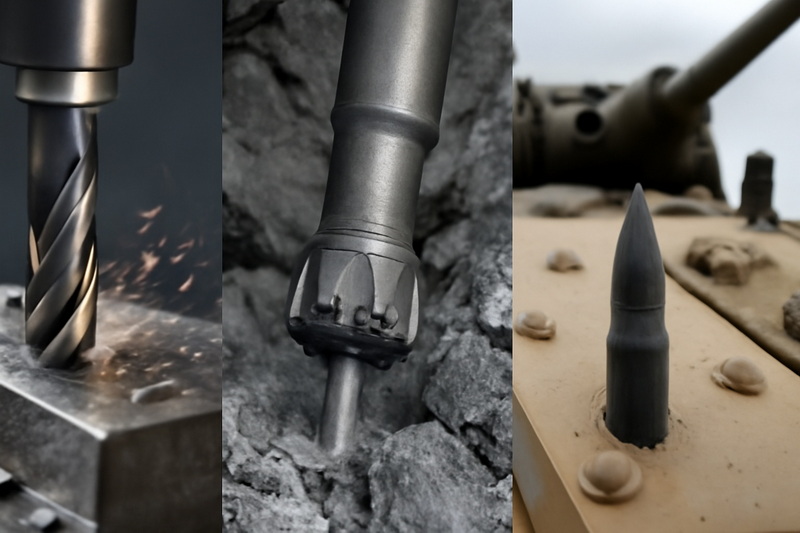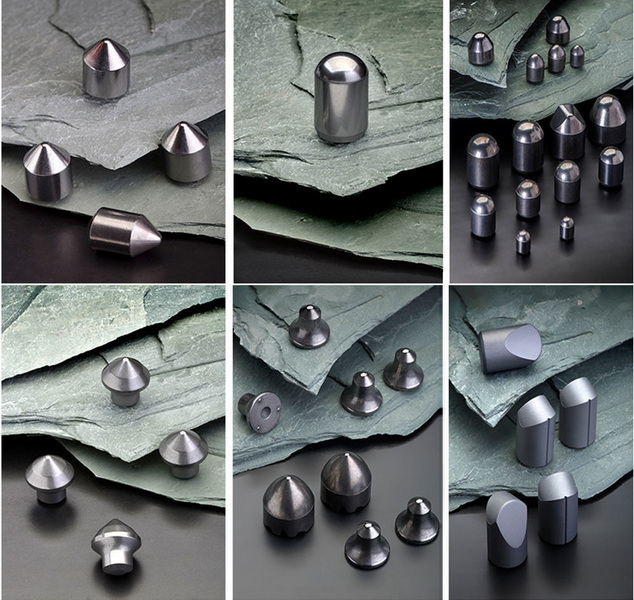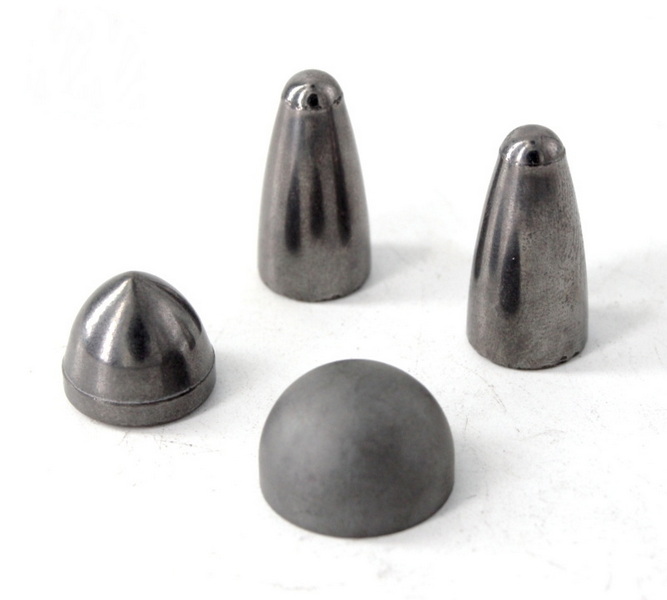Content Menu
● Understanding Tungsten Carbide
● The Global Mining Landscape
>> Major Tungsten-Producing Countries
>> Tungsten Mining in the United States
● From Ore to Tungsten Carbide
>> Extraction and Beneficiation
>> Conversion to Tungsten Carbide
● Environmental and Economic Considerations
>> Environmental Impact
>> Economic Significance
● Tungsten Carbide Recycling
● Tungsten Carbide in Everyday Life
● Historical Context of Tungsten Mining
● Advanced Mining Techniques
● Market Trends and Global Demand
● Technological Advances in Tungsten Carbide Production
● Future Outlook
● Conclusion
● Frequently Asked Questions (FAQ)
>> 1. What is tungsten carbide used for?
>> 2. Where is most tungsten carbide mined?
>> 3. How is tungsten carbide made?
>> 4. Is tungsten carbide environmentally friendly?
>> 5. Can tungsten carbide be recycled?
Tungsten carbide, known for its extraordinary hardness and resistance to wear, is a cornerstone material in industries such as manufacturing, mining, and defense. Its unique properties make it indispensable for cutting tools, drill bits, abrasives, and even military equipment. This article delves into the global origins of tungsten carbide, exploring its mining locations, production processes, environmental and economic impacts, and the latest technological advances shaping its future.

Understanding Tungsten Carbide
Tungsten carbide (WC) is a compound formed from equal parts tungsten and carbon. It is typically produced as a fine gray powder and, through a process called sintering, can be shaped into a variety of forms for industrial use. The material boasts a density of about 15.6 g/cm³, an extreme hardness that rivals diamond, and a melting point exceeding 2,780°C. These characteristics make it ideal for applications where durability and resistance to high temperatures are essential.
Beyond its industrial uses, tungsten carbide is also found in consumer products. Its scratch resistance and sleek appearance have made it a popular choice for wedding bands and other jewelry. Additionally, tungsten carbide is used in light bulb filaments and certain types of military munitions, further highlighting its versatility.
The Global Mining Landscape
Major Tungsten-Producing Countries
China is the undisputed leader in global tungsten production. In 2024, the country produced approximately 67,000 metric tons of tungsten, accounting for over 80% of the world's output. This dominance is underpinned by vast reserves estimated at 2.4 million metric tons. However, China's recent imposition of stricter environmental regulations and export controls has introduced volatility into the global tungsten market, affecting supply chains and prices.
Vietnam is another significant producer, home to the Nui Phao mine—the largest tungsten mine outside China. In 2024, Vietnam produced about 3,400 metric tons of tungsten. Other notable producers include Russia, Bolivia, Rwanda, and Australia, each contributing smaller but important shares to the global supply.
Tungsten Mining in the United States
The United States has a long history of tungsten mining, with significant deposits found in states such as Alaska, Arizona, California, Colorado, Idaho, Montana, North Carolina, New Mexico, Nevada, Texas, and Utah. Historically, the Tungsten City and Tungstar mines in California's Inyo County were major producers, located at high elevations and surrounded by rugged terrain.
While the U.S. once led global tungsten production, most domestic mines are now inactive or operate on a much smaller scale. Nevertheless, facilities like the Curtis Tungsten plant in California and the Kennametal plant in Nevada continue to process tungsten concentrate and manufacture tungsten powder and carbide. These operations help maintain a domestic supply chain for critical industries.
From Ore to Tungsten Carbide
Extraction and Beneficiation
Tungsten is primarily extracted from two main minerals: scheelite and wolframite, with ferberite and huebnerite as additional sources. The mining process begins with the extraction of these ores, which are then crushed and ground to liberate the tungsten-bearing minerals.
Beneficiation techniques play a crucial role in concentrating the tungsten content. Gravity separation and flotation are commonly used methods. Gravity separation exploits differences in mineral density, while flotation uses chemical reagents to separate valuable minerals from waste. The resulting concentrate is further processed to produce intermediate products such as ammonium paratungstate (APT), tungstic acid, and sodium tungstate.
Conversion to Tungsten Carbide
APT is a key intermediate in tungsten production. It is calcined at high temperatures to yield tungsten oxide, which is then reduced to tungsten metal powder in a hydrogen atmosphere. The metal powder is combined with a carbon source—typically soot or graphite—and subjected to high-temperature carburization to form tungsten carbide powder.
Several advanced techniques are used to produce ultra-coarse tungsten carbide powder, including high-temperature reduction, carburization, and the hydrogen reduction of halide boiling layers. These methods ensure the desired particle size and properties, making the powder suitable for various industrial applications.
Environmental and Economic Considerations
Environmental Impact
Tungsten mining and processing can have significant environmental consequences. Habitat disruption, water contamination, and air pollution are common challenges. Mining activities often require the removal of large volumes of earth, which can lead to soil erosion and loss of biodiversity. Processing plants may release heavy metals and other pollutants into nearby water sources, posing risks to aquatic ecosystems and human health.
In response, major producing countries like China have implemented stricter environmental regulations and increased inspections. These measures aim to mitigate the negative impacts of mining and promote more sustainable practices.
Economic Significance
Tungsten carbide is vital to a wide range of industries. Approximately 65% of the market is dedicated to the production of drill bits and cutting tools, which are essential for manufacturing, mining, and oil and gas operations. The material's high value and critical role in industrial processes underscore the importance of a stable and sustainable supply chain.
Price volatility, driven by geopolitical tensions and export restrictions, has heightened interest in alternative sources and recycling. Companies are increasingly investing in research and development to find new ways to extract and process tungsten, as well as to improve recycling rates.
Tungsten Carbide Recycling
Recycling is a key component of the global tungsten carbide supply chain. Scrap from manufacturing, mining, and other industries is collected and processed to recover tungsten and other valuable metals. Recycling not only conserves natural resources but also reduces the environmental footprint of tungsten carbide production.
Advanced recycling technologies, such as hydrometallurgical and pyrometallurgical processes, are being developed to improve recovery rates and reduce energy consumption. These innovations are helping to create a more circular economy for tungsten carbide, where materials are reused and waste is minimized.
Tungsten Carbide in Everyday Life
Beyond its industrial applications, tungsten carbide has found its way into consumer products. Its durability and scratch resistance make it a popular choice for wedding bands and other jewelry. The material is also used in light bulb filaments and certain types of military munitions, where its high melting point and strength are essential.
In the medical field, tungsten carbide is used in surgical instruments and dental tools, thanks to its resistance to corrosion and wear. The automotive industry relies on tungsten carbide for wear-resistant parts, such as engine components and cutting tools used in manufacturing.
Historical Context of Tungsten Mining
Tungsten was first isolated by Spanish chemists Juan José and Fausto Elhuyar in 1783. The metal's unique properties—high density, hardness, and resistance to heat—quickly made it valuable for industrial applications. Early mining efforts were concentrated in Europe and North America, particularly in the United Kingdom, Portugal, and the United States.
The rise of the automotive and aerospace industries in the early 20th century spurred demand for tungsten. During World War II, tungsten became a strategic material, used in armor-piercing projectiles and other military applications. As demand grew, mining operations shifted to Asia, with China emerging as the dominant producer by the late 20th century.

Advanced Mining Techniques
Modern tungsten mining employs a variety of advanced techniques to improve efficiency and reduce environmental impact. Underground mining methods, such as cut and fill, room and pillar, and block caving, allow for safer extraction of ore with minimal surface disturbance. These methods are particularly important in areas with sensitive ecosystems or high population density.
In-situ leaching is another technique being explored for tungsten extraction. This method involves injecting a leaching solution into the ore body to dissolve the tungsten, which is then pumped to the surface for processing. In-situ leaching is less invasive than traditional mining and can reduce the environmental footprint of extraction.
Market Trends and Global Demand
The demand for tungsten carbide has been steadily increasing, driven by its critical role in manufacturing cutting tools and wear-resistant parts. Emerging markets in Asia, particularly China and India, are major consumers of tungsten carbide, fueled by rapid industrialization and infrastructure development.
Technological advancements in electronics and renewable energy sectors are also driving new applications for tungsten carbide. For example, the material is used in the production of high-performance batteries and solar panels, where its durability and resistance to wear are essential.
However, supply chain disruptions—caused by geopolitical tensions, export restrictions, and environmental regulations—have led to price volatility and increased interest in alternative sources and recycling. Companies are investing in research and development to find new ways to extract and process tungsten, as well as to improve recycling rates.
Technological Advances in Tungsten Carbide Production
Recent innovations in tungsten carbide production include the development of nano-structured tungsten carbide powders. These powders offer enhanced hardness and toughness, making them suitable for even more demanding applications. Additive manufacturing techniques, such as 3D printing, are being explored to create complex tungsten carbide components with reduced waste.
Advanced processing methods, such as spark plasma sintering and hot isostatic pressing, are also being used to improve the properties of tungsten carbide. These techniques allow for the production of materials with finer grain structures and higher densities, resulting in superior performance.
Future Outlook
The future of tungsten carbide mining and production is likely to be shaped by a combination of technological innovation, environmental regulation, and market dynamics. Increased recycling efforts and the development of synthetic alternatives may alleviate some supply pressures. Meanwhile, exploration for new deposits outside traditional mining regions is ongoing, with potential discoveries in Africa and South America.
Governments and industry leaders are working to establish more sustainable mining practices and to reduce the environmental impact of tungsten production. Investments in research and development are expected to yield new technologies for extraction, processing, and recycling, ensuring a stable and sustainable supply of this critical material.
Conclusion
Tungsten carbide is a material of immense industrial and economic significance. Mined primarily in China, but also in Vietnam, Russia, Bolivia, Rwanda, and Australia, tungsten is transformed through complex extraction, beneficiation, and chemical processing steps into the versatile and durable compound known as tungsten carbide. The United States maintains a presence in tungsten mining and processing, though on a smaller scale than in the past.
Environmental considerations and recycling efforts are increasingly important in ensuring the sustainability of this critical material. As global demand for tungsten carbide continues to grow, so too does the need for responsible mining and production practices. Technological advances, market trends, and ongoing exploration promise to shape the future of tungsten carbide, ensuring its continued importance in industry and everyday life.

Frequently Asked Questions (FAQ)
1. What is tungsten carbide used for?
Tungsten carbide is primarily used in cutting tools, drilling equipment, abrasives, and wear-resistant parts in machinery. It is also used in jewelry, military munitions, and light bulb filaments due to its exceptional hardness and durability.
2. Where is most tungsten carbide mined?
Most tungsten carbide is sourced from tungsten mined in China, which accounts for over 80% of global production. Other significant producers include Vietnam, Russia, Bolivia, Rwanda, and Australia.
3. How is tungsten carbide made?
Tungsten carbide is made by extracting tungsten from ores such as scheelite and wolframite, processing the ore into intermediate products like ammonium paratungstate (APT), and then converting APT into tungsten metal powder. The metal powder is combined with carbon and subjected to high-temperature carburization to form tungsten carbide.
4. Is tungsten carbide environmentally friendly?
While tungsten carbide itself is inert and durable, the mining and processing of tungsten ore can have significant environmental impacts, including habitat disruption and pollution. Efforts are being made to improve environmental practices and increase recycling to mitigate these effects.
5. Can tungsten carbide be recycled?
Yes, tungsten carbide can be recycled. Scrap from manufacturing, mining, and other industries is collected and processed to recover tungsten and other valuable metals, helping to conserve resources and reduce environmental impact.
















